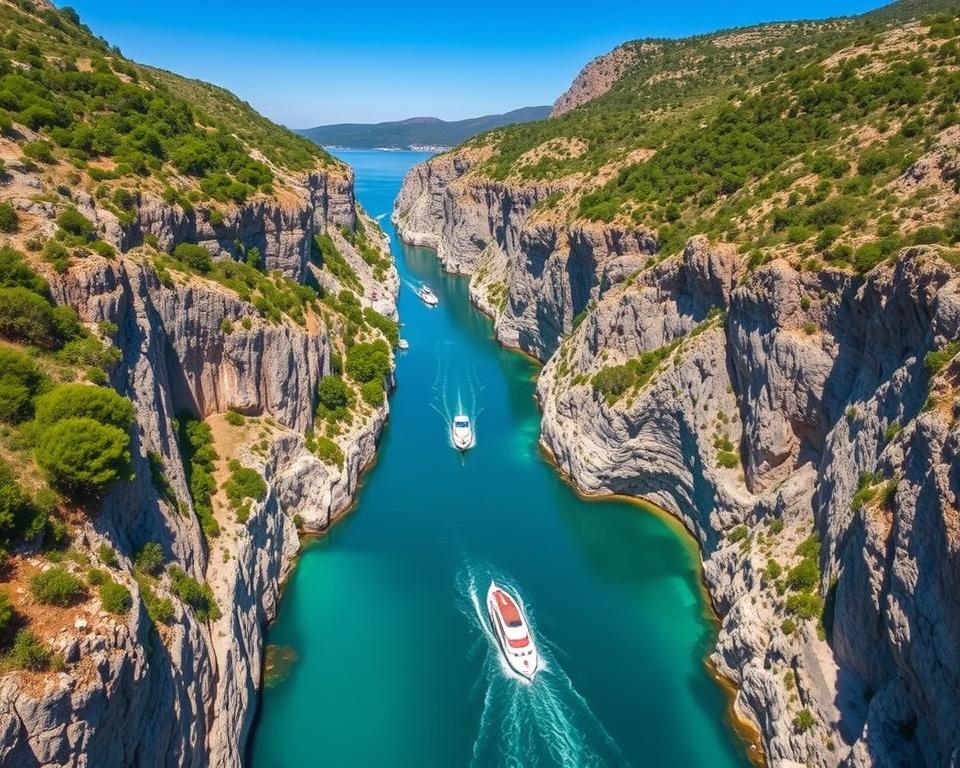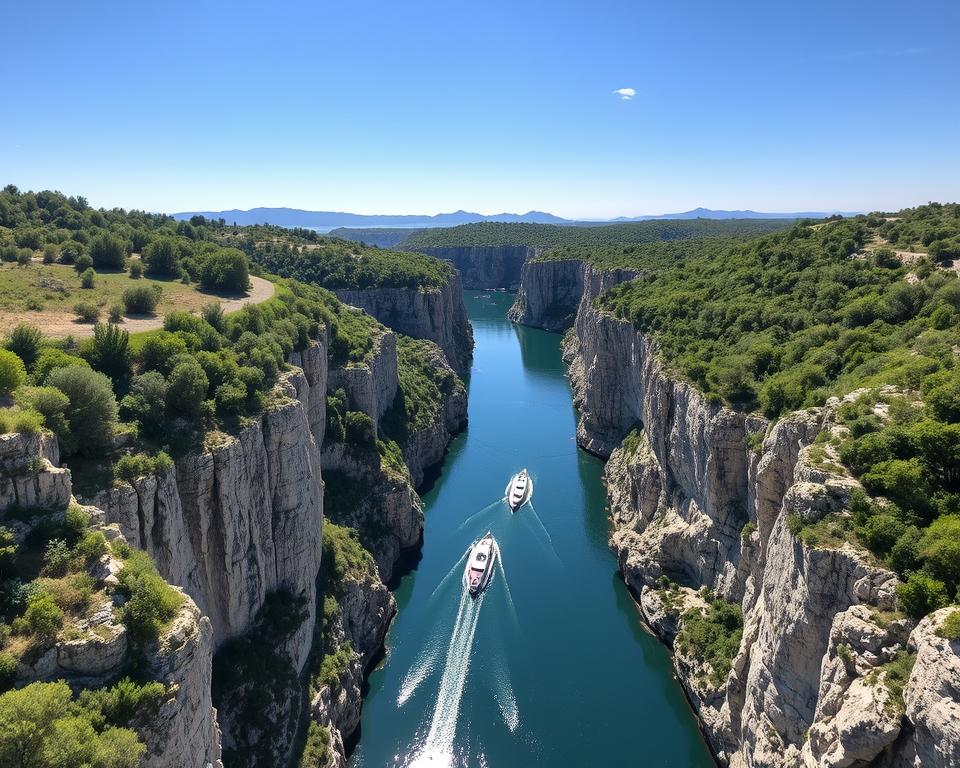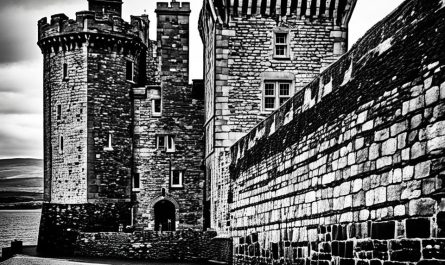The Corinth Canal is in the heart of Greece. It’s a remarkable engineering feat that has amazed many. This waterway connects the Gulf of Corinth and the Saronic Gulf. It has been key for maritime trade and travel for centuries.
The Corinth Canal shows human ingenuity and determination. It has overcome big geographical challenges. Now, it’s a famous landmark in the area.
The canal’s location is strategic. It cuts through the Isthmus of Corinth. This makes it a vital shortcut for ships between the Adriatic and Aegean Seas. The canal was carved through tough terrain, changing Greece’s landscape.
It has made a unique and captivating waterway. Both locals and visitors are fascinated by it.
Read interesting things at : grenzgamer
Key Takeaways
- The Corinth Canal is a historic waterway in Greece that connects the Gulf of Corinth and the Saronic Gulf.
- It was an engineering marvel that overcame significant geographical challenges to create a vital maritime shortcut.
- The canal’s strategic location, cutting through the Isthmus of Corinth, has reduced the distance and travel time for ships navigating between the Adriatic and Aegean Seas.
- The Corinth Canal has played a crucial role in facilitating maritime trade and transportation in the region for centuries.
- The canal is a renowned landmark in Greece, capturing the imagination of both locals and visitors.
The Corinth Canal: A Marvel of Engineering
The Corinth Canal is a symbol of human creativity and perseverance. It links the Gulf of Corinth and the Saronic Gulf, once divided by the Isthmus of Corinth. Building this canal was a huge task, facing steep terrain and unstable rocks.
Connecting the Gulf of Corinth and the Saronic Gulf
The canal was meant to cut down the sea route between the Adriatic and Aegean Seas. It saved ships about 185 miles (300 kilometers). Its central Mediterranean location made it key for trade and travel.
Overcoming Geographical Challenges
Building the Corinth Canal was a major challenge. The isthmus had steep cliffs and shaky rocks. Engineers and workers used new methods and hard work to overcome these obstacles. This made the Corinth Canal a true marvel of corinth canal engineering.
| Geographical Challenges | Engineering Solutions |
|---|---|
| Steep Terrain | Extensive excavation and slope stabilization |
| Unstable Rock Formations | Reinforcement and anchoring techniques |
| Narrow Isthmus | Careful planning and execution of the canal’s design |
The Corinth Canal shows the skill and will of those who built it. They faced big geographical challenges in the gulf of corinth and saronic gulf area.
The Significance of the Corinth Canal
The Corinth Canal is a key part of Greek history. It has greatly helped ships travel faster and shorter between the Ionian and Aegean Seas. This shows its maritime importance for the area.
The canal’s location and engineering are amazing. It’s a big part of Greek history and shows Greece’s ability to solve big challenges. Building it took many years, showing the Greek people’s hard work and smart thinking.
“The Corinth Canal is not just a feat of engineering, but a testament to the enduring spirit of the Greek people.”
The Corinth Canal is also a big cultural and historical spot. People from all over come to see it and learn about its history. This makes it even more important as a landmark of Greek history.
| Key Benefits of the Corinth Canal | Historical Significance |
|---|---|
|
|
The Corinth Canal has made a lasting impact on Greece‘s history and seas. Its importance goes beyond just helping ships. It shows the Greek people’s creativity and never-give-up spirit.
A Brief History of the Corinth Canal
The idea of a canal across the Isthmus of Corinth has long fascinated rulers and engineers. It started in ancient times but took until the 19th century to become a reality.
Ancient Dreams and Failed Attempts
In the 7th century BC, Greek tyrant Periander first tried to build a canal. But, he had to stop due to the technology back then. Later, Julius Caesar and Roman Emperor Nero also wanted to do it, but they faced the same problems.
Construction and Completion in the 19th Century
In 1882, a French company got the chance to build the canal. They started right away but hit many hurdles. Despite these, they finished the Corinth Canal in 1893 after over a decade of hard work.
“The Corinth Canal was a feat of engineering that had eluded rulers and visionaries for centuries. Its successful completion in the 19th century was a testament to the indomitable human spirit and the power of technological progress.”
Navigating the Corinth Canal
Going through the Corinth Canal is a special and exciting journey for ships. The canal is very narrow, with steep sides and sharp turns. This makes it a challenge for captains and their teams to navigate.
The ship transit through the Corinth Canal needs careful planning and skill. Captains must be very precise, considering the canal’s depth, currents, and the risk of hitting the walls. The canal’s management is key to keeping traffic moving smoothly and avoiding delays.
The Corinth Canal uses a system to control traffic and schedules. Ships must follow rules, like speed limits and communication rules. This helps manage the canal’s unique layout and keeps maritime trade flowing.
| Transit Time | Vessel Size Limit | Annual Transits |
|---|---|---|
| 40-60 minutes | 6,300 DWT | 11,000+ |
The Corinth Canal navigation shows the creativity and hard work of engineers and sailors. It’s a key part of Greece’s maritime history. The canal is a vital link for international trade and shows Greece’s dedication to it.
The Corinth Canal: A Maritime Shortcut
The Corinth Canal is a key shortcut for ships. It lets them skip the long way around the Peloponnese peninsula. This engineering wonder connects the Gulf of Corinth to the Saronic Gulf. It cuts down travel time and distance for ships going between the Ionian and Aegean Seas.
Reducing Travel Time and Distance
Before the canal, ships had to go around the Peloponnese. This made their trips longer and more tiring. The Corinth Canal changed all that, saving a lot of time and distance.
Vessels can now go through the 6.4-kilometer (4-mile) canal. This cuts hours and miles off their journey.
- The Corinth Canal reduces the distance between the Ionian and Aegean Seas by approx. 185 miles.
- Ships can now complete the crossing in just 30-40 minutes, compared to the previous journey of several hours around the Peloponnese.
- This dramatic time and distance savings makes the Corinth Canal a highly efficient corinth canal maritime shortcut for maritime traffic.
The Corinth Canal is now a crucial part of the region’s shipping routes. It has greatly improved travel time reduction and distance savings for ships.
Geological Challenges of the Corinth Canal
The Corinth Canal is a remarkable feat of engineering. It faces ongoing geological challenges that test human ingenuity. This waterway connects the Gulf of Corinth and the Saronic Gulf. It battles nature’s forces, with unstable rock and soil threatening its structure.
Weathering and Erosion: Constant Threats
The canal’s location, carved through limestone and shale, makes it vulnerable. Weathering and erosion, caused by rain, wind, and temperature changes, damage its walls. Regular maintenance and reinforcement are needed to keep it safe.
Weathering breaks down rock and soil, causing cracks and instability. Erosion, driven by water and wind, worsens these problems. This leads to crumbling and collapse of the canal’s walls over time.
| Geological Challenge | Impact on the Corinth Canal | Mitigation Efforts |
|---|---|---|
| Weathering | Formation of cracks and instability in the canal’s structure | Regular maintenance and reinforcement of the canal’s walls |
| Erosion | Collapse and crumbling of the canal’s walls over time | Continuous monitoring and prompt repairs to maintain the canal’s structural integrity |
The engineering team must constantly monitor and address these challenges. They work to keep the waterway safe and reliable for ships.

The Corinth Canal’s location, carved through the limestone and shale of the isthmus, makes it susceptible to the relentless processes of weathering and erosion.
The Engineering Feat of the Corinth Canal
Building the corinth canal engineering feat was a huge challenge. It needed new solutions and advanced tech for its time. The steep terrain, unstable rocks, and other obstacles showed the skill of the designers and builders.
The construction challenges were tough. The rocky mountains needed a lot of digging and blasting. Also, unstable rocks could cause landslides and cave-ins, threatening the project.
To solve these technological innovations, engineers used new methods and tools. They used steam-powered machines for the first time in big projects. This made digging faster and more efficient. Dynamite also changed how rocks were broken, making blasting safer and more precise.
“The Corinth Canal is a testament to the ingenuity and determination of the engineers who brought this ambitious project to life.”
Despite many obstacles, the builders of the Corinth Canal succeeded. They created a waterway that’s key for Greece’s sea transport. The Corinth Canal shows what humans can do with innovation and determination, even against tough challenges.
The Corinth Canal: A Landmark of Greece
The Corinth Canal is a key part of Greek culture and history. It’s not just important for its role in trade and travel. It’s also a symbol of Greece’s engineering skills and love for the sea. This makes it a beloved part of Greece.
Cultural Significance
The Corinth Canal is a source of pride for Greeks. It shows their creativity and hard work. The canal’s design and construction have inspired many artists and writers in Greece.
Historical Importance
The Corinth Canal is also very important in Greece’s history. It has helped with trade and military plans for centuries. Building the canal was a huge achievement that changed the area’s economy.
The Corinth Canal is a symbol of Greece’s engineering and maritime history. It shows the country’s ability to overcome challenges and achieve great things.
Corinth Canal: A Unique Tourist Attraction
The Corinth Canal is a top spot for tourists in Greece. It lets visitors see the amazing engineering and watch ships pass through. There are great spots along the canal to see the action and enjoy the views.
Viewing Platforms and Vantage Points
At the Corinth Canal, you can find many viewing platforms and vantage points. These spots give you wide views of the canal and the area around it. They are set up to show off the canal’s special features and the ships that go through.
The Corinth Canal Bridge is a favorite place to watch. It has a walkway high above the water for amazing views. Another great spot is the Acrocorinth Fortress. It’s on a hill and gives you a view of the whole canal and the land around it.
| Viewing Platform | Unique Features |
|---|---|
| Corinth Canal Bridge | Elevated walkway for panoramic views |
| Acrocorinth Fortress | Bird’s-eye view of the canal and surrounding landscape |
| Canal-side Observation Decks | Close-up views of ships navigating the waterway |
These viewing platforms and vantage points along the Corinth Canal let visitors dive into the wonder of this engineering marvel. They also get to see the stunning scenery that surrounds it.
The Impact of the Corinth Canal on Maritime Trade
The Corinth Canal has changed maritime trade in the area a lot. It connects the Ionian and Aegean Seas, making shipping better and cheaper. This has helped the local economy a lot.
The canal is a key route for ships. It cuts down travel time and distance. Ships don’t have to go around the Peloponnese anymore.
| Metric | Before Corinth Canal | After Corinth Canal |
|---|---|---|
| Travel Time | Around 10 hours | Around 1 hour |
| Distance Traveled | Approximately 185 miles | Approximately 4 miles |
The Corinth Canal has had a big effect on shipping. It makes corinth canal maritime trade better. This means ships save money and make more profit. The whole area benefits from this.
The canal is a key part of the global shipping network. It connects the Mediterranean Sea to the Adriatic and more. This brings a lot of corinth canal maritime trade to the area. It helps the local economy grow.
“The Corinth Canal has revolutionized maritime trade in the region, serving as a crucial gateway connecting the Ionian and Aegean Seas.”
The Corinth Canal has changed corinth canal maritime trade and the shipping industry a lot. It makes shipping more efficient and cheaper. This has a big positive impact on the area.
The Corinth Canal: Future Challenges and Maintenance
The Corinth Canal is a remarkable feat of engineering, vital to Greece’s transport for over a century. It faces ongoing challenges to stay viable. The canal’s narrow width and the threat of weathering and erosion require constant reinforcement and improvement.
One major concern is the infrastructure of the Corinth Canal. Its walls and foundations face constant wear from water and severe weather. Keeping the canal safe and functional for ships is essential.
Maintaining the Corinth Canal is a big task. Dredging is needed to clear sediment and debris. Regular checks and repairs are also crucial to fix any problems.
To tackle these future challenges, the Greek government must invest in upgrades and maintenance. This could include strengthening walls, controlling erosion, and using new dredging tech. These steps will help the canal stay a key part of Greece’s transport network.
“The Corinth Canal is a unique and irreplaceable asset for Greece, and its preservation is of utmost importance for the nation’s economic and maritime future.”
As the Corinth Canal remains vital for Greece’s maritime trade, addressing its future challenges is crucial. Maintaining its infrastructure is key to its long-term success and Greece’s prosperity.
Interesting Facts About the Corinth Canal
The Corinth Canal is a remarkable engineering feat. It’s filled with fascinating trivia and details that make it even more interesting. Exploring its history and engineering marvels helps us appreciate this iconic Greek landmark more.
Did you know the Corinth Canal has ancient roots? The idea of a canal between the Gulf of Corinth and the Saronic Gulf started in the 7th century BC. The first attempts were made by the Greek tyrant Periander. But, it took centuries for the canal to be finished in the 19th century.
The construction of the Corinth Canal was a huge engineering challenge. It had to cut through the narrow Isthmus of Corinth. The team faced many geological obstacles, like different rock types and unstable slopes. The work was hard, taking years and using new techniques.
- The Corinth Canal is 6.4 kilometers (4 miles) long, 21.3 meters (70 feet) wide, and 8 meters (26 feet) deep.
- It took more than a century to complete the canal, with construction starting in 1881 and the first ship passing through in 1893.
- The canal’s steep walls, reaching up to 90 meters (300 feet) in height, have been a constant challenge, requiring ongoing maintenance and reinforcement to prevent erosion and landslides.
The Corinth Canal was not just an engineering feat. It was also a symbol of Greece’s cultural and historical significance. Its completion was seen as a triumph of Greek ingenuity and a sign of the country’s modernization.
| Fact | Value |
|---|---|
| Length | 6.4 km (4 miles) |
| Width | 21.3 m (70 feet) |
| Depth | 8 m (26 feet) |
| Construction Period | 1881 to 1893 |
| Wall Height | up to 90 m (300 feet) |
The Corinth Canal’s history, engineering, and cultural importance continue to fascinate people. It’s a unique and remarkable part of Greece’s heritage.

“The Corinth Canal is a marvel of engineering, a testament to human ingenuity and a symbol of Greece’s rich history.”
Conclusion
The Corinth Canal is a symbol of Greece’s engineering skills and maritime history. It has been a key shortcut for ships and a sign of Greek creativity. Despite challenges, it remains a beloved spot for tourists and locals alike.
The canal’s role as a maritime center and cultural icon is clear. Its upkeep and adaptation to new shipping needs are vital. This will keep its legacy alive for future generations.
The Corinth Canal’s story shows the Greek people’s drive and creativity. It amazes and motivates everyone who sees it. It reminds us of Greece’s deep maritime past and its spirit of discovery and growth.



